York Horse Tramways
(York Tramways Company, later the City of York Tramways Company)
History
York's 4ft-gauge horse tramway — which was owned and operated by the York Tramways Company — opened for business on the 27th October 1880.
Proposals for constructing a horse tramway in the city were first placed before the council in October 1878, the promoters (Peterson and Peterson) securing the latter's support before applying for a provisional order in early 1879. Although powers for the tramway were granted on the 11th August 1879 (in that year's Tramway's Confirmation bill), construction work did not start until nearly a year later on July 1880, in part due to a falling out between the newly formed YTCo and the promoters, who were unceremoniously pushed out of the scheme.
The YTCo was keen to use steam traction — a much cheaper option than horses — though it first had to persuade the council; perhaps surprisingly, the council agreed to allow a 3-month trial, which involved a Perrett engine, an early form of steam tram and passenger carrying vehicle combined into a single unit. The first trials, which started in October 1880, were not only disappointing technically, but also resulted in numerous complaints about the nuisance caused by the vehicle; whilst a second improved vehicle was eventually passed for operation on the 3rd December, the company terminated the trials only 4 days later after yet another tranche of complaints.
The initial tramway line, which ran northwards from a terminus outside the Plough Inn in Fulford, along Fulford Rd and Fishergate to Castle Mills Bridge, was extended over the bridge to Castlegate during Easter 1881. Powers to extend it into the city proper were obtained on the 18th June 1881, work commencing in spring 1882. The extension, which opened on the 29th July, took the tramway to its maximum size fo 2.76 miles, running from Castlegate along the newly built Clifford St, before turning westwards over the Ouse, through Micklegate Bar, and along Micklegate and Blossom St to a terminus at the Mount. A branch line was also constructed; this ran northwards along Railway St, Rougier St and Station Rd to a terminus outside the North Eastern Railway's main station.
Unfortunately, the new lines were built down to a price, the track costing only around 50% of the price per mile of the original, well-constructed line; whilst this initially saved the company money, it was to cost them dear in the end, as the track not only required constant and expensive maintenance, but it also brought the company into repeated conflict with the council.
In 1885, an approach was received by the rather grandly titled Imperial Tramways Company, which would over the course of its existence, exercise control — either directly or through subsidiaries — over the following tramways: Blackrock and Kingstown Tramway; Bristol Tramways; Gloucester Tramways; Dublin Southern District Tramways; Middlesbrough and Stockton Tramways; Middlesbrough, Stockton and Thornaby Electric Tramways; Reading Tramways; Stockton and Darlington Steam Tramways; and the West Metropolitan Tramways (which on purchase was immediately transferred to the newly formed London United Tramways). The ITCo formally took over the tramway on the 1st of January 1886, having first formed a new subsidiary — the City of York Tramways Company — to manage and operate it.
One of the first acts of the CYTCo was to close the loss-making railway station branch, which it had done by August 1886, subsequently managing to evade the expense of removing the track for over 8 years, greatly irritating the council in the process. Although passenger numbers were fairly healthy — climbing steadily through the 1890s to a peak of almost 1 million in 1900 — the tramway was in reality too small to be a viable commercial proposition, profits only being wrought at the expense of strict cost control. Whilst the company was seemingly happy to operate increasingly decrepit vehicles over badly maintained track, and with animals that did not receive the best quality fodder, this approach neither endeared it to the travelling public nor the council.
Under the terms of the Tramways Act of 1870, the council was entitled to acquire the tramway 21 years after the original act had passed into law, which meant that the Fulford line could be compulsorily purchased after the 11th August 1900, and the rest of the system on the 2nd June 1902; however, if the council did not give notice of its intentions within 6 months of those dates, then it would forfeit its right to purchase for a further seven years. The CYTCo therefore had two choices, either to run the system into the ground and then hand it over at scrap prices, or to bring forward proposals to convert the system to a more modern form of traction; the latter would of course have been an expensive course of action, and one which could only have been entertained if the company were given a guarantee in respect of its tenure. It quickly became clear however, that the council was unwilling to give up its right to purchase the undertaking, and though the company eventually obtained powers (in 1897) to convert and extend the system, the threat of compulsory purchase remained, as well as a council veto over the means of traction adopted.
This effectively put paid to any plans the company had to improve the tramway, so there things lay until 1899, when the corporation approached the company to see how much they would be prepared to sell the undertaking for (before the compulsory purchase date). The two parties initially failed to agree on a price, but with the compulsory purchase date fast approaching, and with the very real prospect of losing the Fulford line (including the depot), the company had little choice but to come to terms. An agreement was reached in principle on the 29th January 1901 for the council to take possession in 1903, thus allowing it time to develop plans and acquire the necessary powers, the company continuing to operate the tramway in the interim. Unfortunately, the council subsequently saw fit to put its plans for a municipal tramway to a poll of ratepayers (in February 1902), where they were decisively rejected, which not only left the CYTCo in possession of the system, but one with much improved track, courtesy of the council, who had extensively relaid it in anticipation of the acquisition.
Though letting matters rest there for a while, the council was still intent on constructing and operating a municipal tramway system, sounding the company out once again in 1905, ahead of the next compulsory purchase date in August 1907, though once again agreement proved elusive. The tramcars had meanwhile reached the end of their working lives, the council applying pressure to the company by refusing to grant licences for their operation, forcing the company to finally spend some money, even though passengers numbers were plummeting, three cars being completely rebuilt and five new ones purchased.
In 1906, a new company entered the scene with proposals to construct a surface-contact electric tramway in the city, a development which the council resolutely blocked, but which also gave new impetus to its own plans, agreement being reached with the CYTCo in early 1907 to purchase the undertaking in 1909. The council duly acquired powers — on the 19th October 1908 — to convert the horse tramway to electric traction and to build new lines, taking over operation of the horse tramway on the 27th February 1909. Construction on the new system started on the 1st September 1909, the horse tramway closing 6 days later on the 7th September 1909 to enable the new track to be laid to the narrower gauge of 3ft 6ins.
Uniforms
Photographs of the first twenty years of the tramway's existence — during the tenure of the York Tramways Company (1880 to 1886) and its successor (the City of York Tramways Company 1886 onwards) — appear not to have survived, so it is currently impossible to state whether or not uniforms were worn during this era (i.e., up until 1900). However, given that photographs taken around the turn of the century (see below) show crews wearing informal attire, (i.e., shirt, jacket and tie, along with a plain kepi-style cap), it seems reasonable to assume that uniforms were not worn in the preceding 20 years.
By the time new trams were placed in service in 1905, and when the photographic record becomes much richer, crews had a notably smarter appearance, though it was still probably self-purchased informal attire. Kepi-style caps were worn (along with flat caps towards the end of services), which though apparently issued bye the company, were devoid of insignia.
It is currently unclear what style of uniform, if any, was worn by inspectors.
Further reading
For a history of the tramway, see 'The Horse Tramways of York' by Hugh Murray; Light Rail Transit Association (1980).
Images
Horse tram drivers and conductors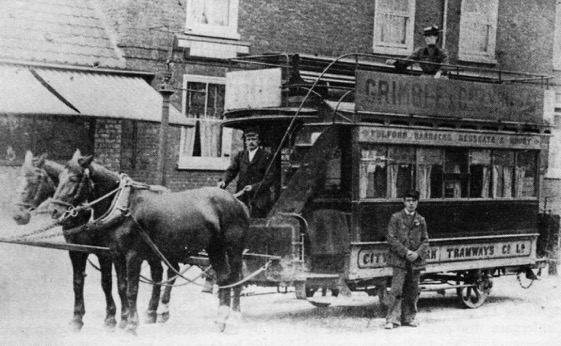
A driver and conductor pose for the cameraman with an unidentified horse car at the Fulford terminus — photo undated, but certainly taken prior to 1905, and possibly in the 19th Century. Both men appear to be wearing informal attire along with kepi-style caps. Photo courtesy of the Tramways and Light Railway Society, with thanks to David Voice.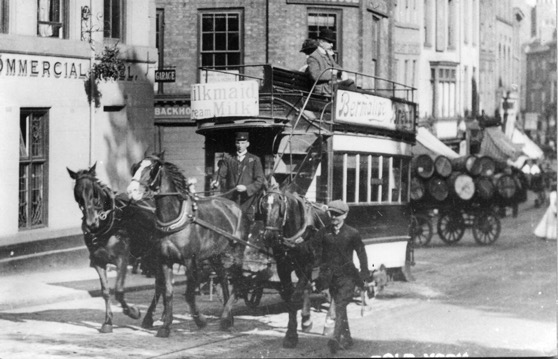
A rare 'in motion' photograph of an unidentified horse car in Micklegate, being assisted up the incline by a trace horse, whose name was either 'Dobbin' or 'Jumbo' (depending on which history you believe) — photo undated, but probably early Edwardian. Photo courtesy of the Tramways and Light Railway Society, with thanks to David Voice.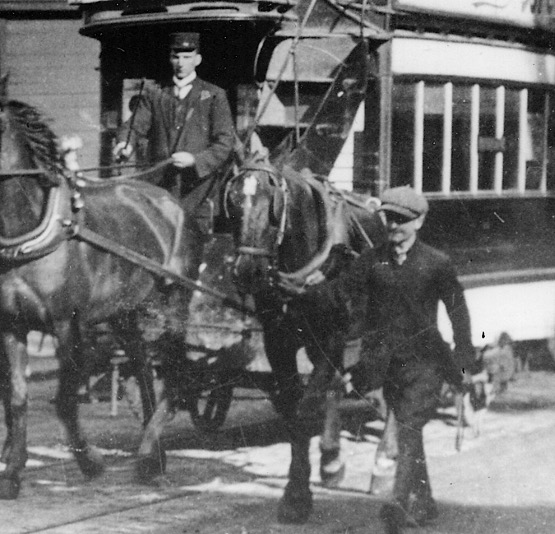
A blow-up of the above photo showing the driver, who appears to be wearing an informal jacket along with an unmarked kepi-style cap.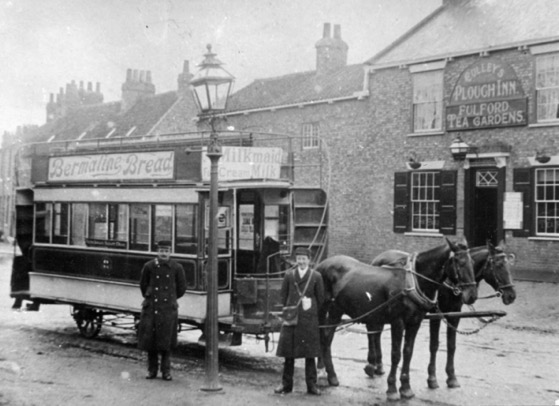
One of the new 1905-acquired horse cars and its crew at the Fulford terminus (with the Plough Inn in the background) — photo undated, but given the relatively good condition of the vehicle, probably taken not too long after its delivery. Photo courtesy of the Tramways and Light Railway Society, with thanks to David Voice.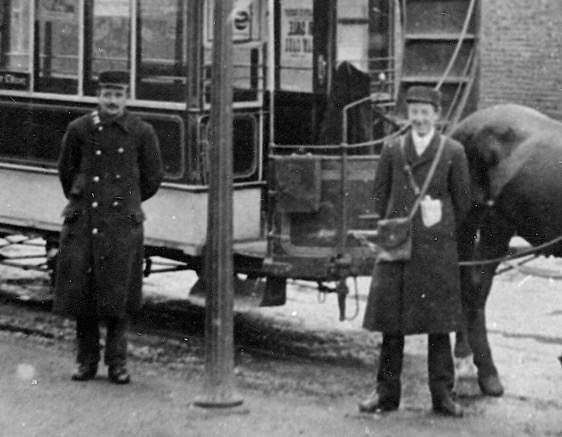
A blow-up of the above photo showing the driver and the conductor, both in company-issued kepi-style caps (seemingly devoid of badges) along with what are probably self-purchased greatcoats given the different styles. The driver's right-hand collar bears insignia of some description.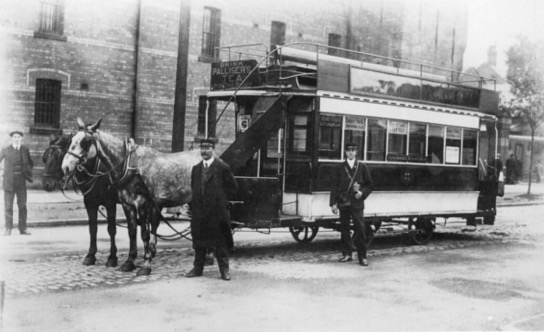
A very smart driver and his equally smart conductor pictured outside the Armoury of Imphal Barracks on Fulford Rd — photo undated, but certainly taken after 1905, though probably not too long after given the smart condition of the vehicle. Photo courtesy of the Tramways and Light Railway Society, with thanks to David Voice.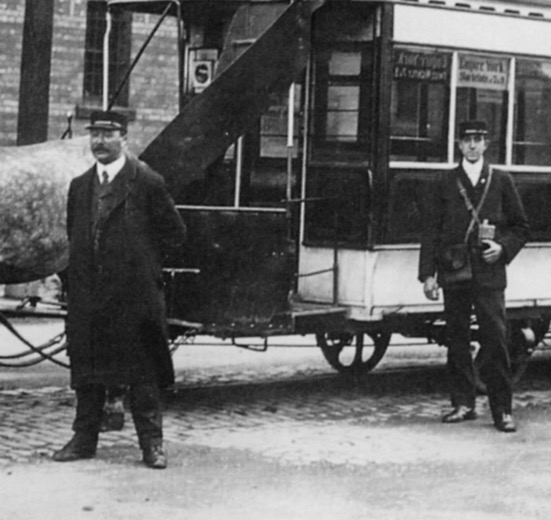
A blow-up of the above photo showing the crew; although smartly attired, it is probably informal rather than a uniform.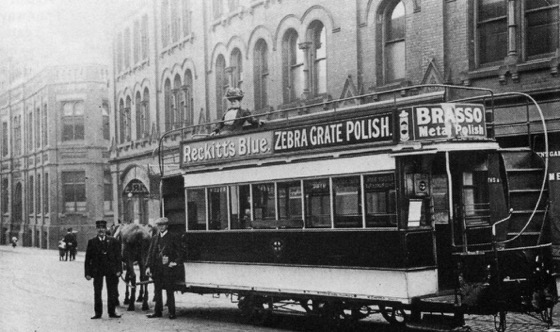
The crew of Tramcar No 5, a 1905-acquired vehicle, stand at the City terminus outside the Empire Theatre — photo undated, but certainly mid-to-late Edwardian. Photo courtesy of the Tramways and Light Railway Society, with thanks to David Voice.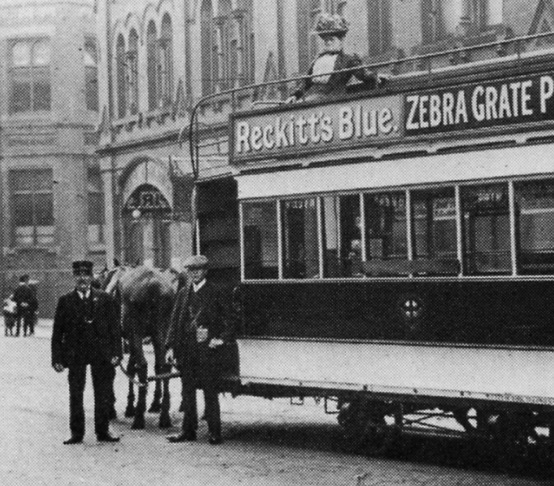
A blow-up of the above photo, the driver in single-breasted jacket and unmarked kepi, the conductor in informal attire.